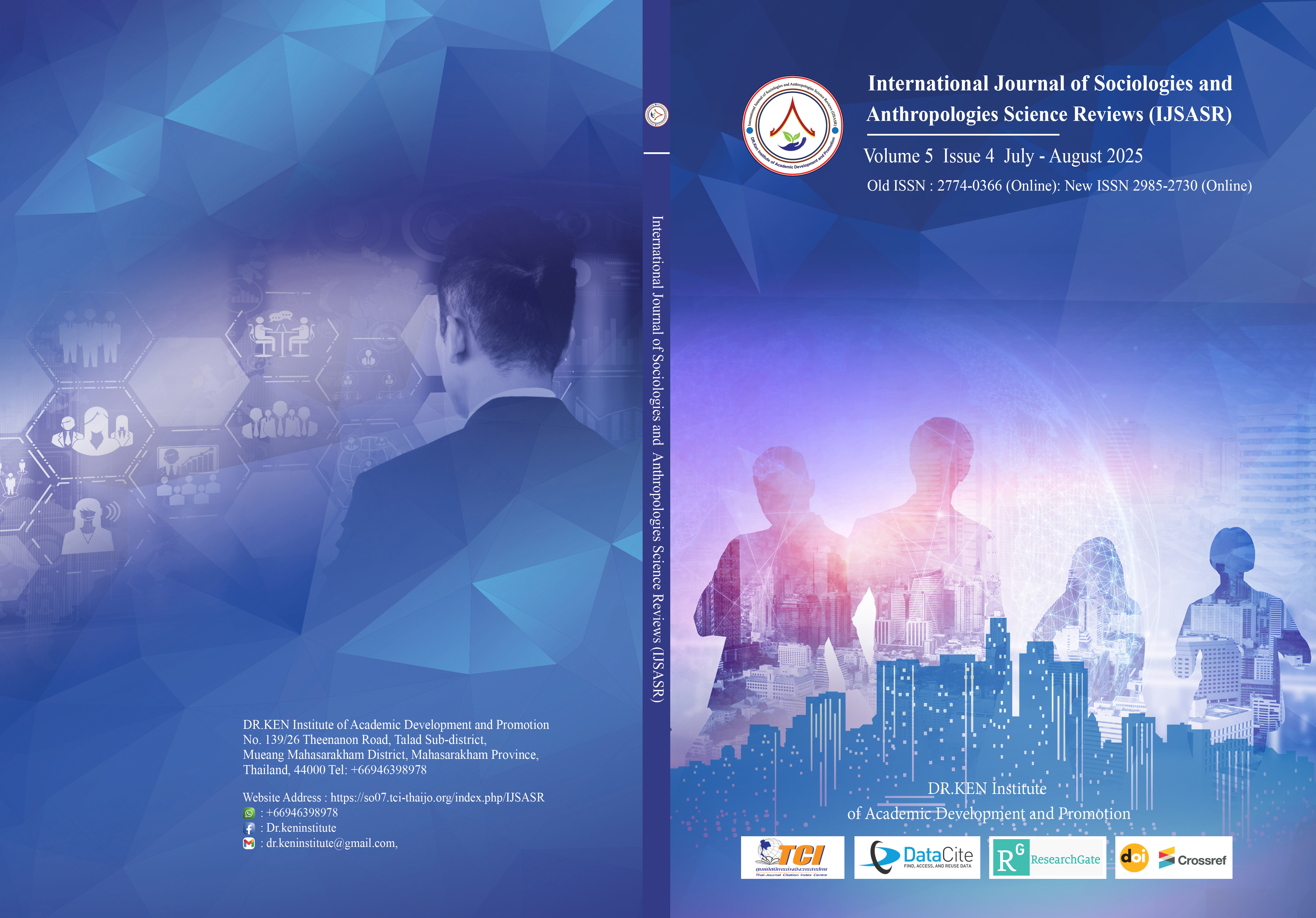Development of Managerial Guidelines to Promote Dragon and Lion Dance in Middle School
Main Article Content
Abstract
Background and Aim: The main factor restricting the development of the dragon and lion dance in most Middle schools is the lack of funds. Leadership is not important enough, no specialization of teachers, a Lack of teaching materials and equipment, Insufficient sites, and the Dragon and lion cultural atmosphere is not strong. So, the main objective of this research was to develop the managerial guidelines to promote dragon and lion dance in middle school.
Materials and Methods: This study was a mixed-method study, which combines quantitative and qualitative research. The research begins by identifying the influencing factors affecting their integration into school programs through a structured questionnaire (IOC=0.73, Cronbach alpha=0.84) administered to 222 middle school students. Subsequently, expert interviews were conducted to gather qualitative insights among 5 experienced professionals, which informed the formulation of a managerial guideline framed within the POLC management function, PESTLE theoretical frameworks, and the PDCA cycle. This dual approach ensures that the guidelines are both strategic and pragmatic, addressing the diverse obstacles while leveraging available opportunities. To validate and refine these guidelines, a focus group consisting of 12 experts in education, cultural arts, and non-profit management convened to engage in a critical discussion on the proposed content. Finally, the connoisseurship method, consisting of 5 experts, was employed to review and confirm the managerial guidelines.
Results: 1) The priority needs of the development of managerial guidelines to promote dragon and lion dance in middle school are at a high level (PNImodified=0.32). Moreover, the order of requirements from highest to lowest is arranged as following: Leading (PNImodified=0.39), Controlling (PNImodified=0.39), Social (PNImodified=0.39), Planning (PNImodified=0.38), Organization (PNImodified=0.37), Environmental (PNImodified=0.33), Politics (PNImodified=0.23), Technical (PNImodified=0.23), Economic (PNImodified=0.22), Legal (PNImodified=0.22). 2) The managerial guideline to promote dragon and lion dance in middle school corresponds to 4 parts rooted in the Plan-Do-Check-Act (PDCA) cycle. There were 10 elements in the Plan part, there were 10 elements in the Do part, there were 10 elements in the Check part, and there were 10 elements in the Act part.
Conclusion: This iterative process confirmed the effectiveness and feasibility of the managerial recommendations, ensuring that they align with the needs of middle schools while fostering the rich cultural heritage of dragon and lion dance.
Article Details

This work is licensed under a Creative Commons Attribution-NonCommercial-NoDerivatives 4.0 International License.
Copyright on any article in the International Journal of Sociologies and Anthropologies Science Reviews is retained by the author(s) under the under the Creative Commons Attribution-NonCommercial-NoDerivatives 4.0 International License. Permission to use text, content, images, etc. of publication. Any user to read, download, copy, distribute, print, search, or link to the full texts of articles, crawl them for indexing, pass them as data to software, or use them for any other lawful purpose. But do not use it for commercial use or with the intent to benefit any business.

References
Akman, M. K. (2020). Defense Management and PESTLE analysis. Ante Portas–Security Studies, 1(14), 93-102.
Al-Mahairah, M. S., Manoharan, G., Singh, J., & Krishna, S. H. (2022). Principles of Management. Book Rivers.
Brouwer, N., Joling, E., & Kaper, W. (2022). Effect of a person-centered, tailor-made, teaching practice-oriented training program on the continuous professional development of STEM lecturers. Teaching and Teacher Education, 119, 103848.
Cai, K. (2005). The aesthetic idea of creating a dragon and lion optional routine. The first National Dragon and Lion Paper Report.
Capone, R. (2022). Blended learning and student-centered active learning environment: A case study with STEM undergraduate students. Canadian Journal of Science, Mathematics and Technology Education, 22(1), 210-236.
Chen, L., Liu, Y., Zuo, T., Meng, T., Xu, Y., Luo, P., & Huang, M. (2022). Teaching Practice of Dragon and Lion Dance in Colleges and Universities with the Support of Big Data Technology. Wireless Communications and Mobile Computing, 2022(1), 4733795.
Deming, W. (1986). Out of the crisis. Massachusetts Institute of Technology. Center for Advanced Engineering Study, Cambridge, МА, 510.
Ghatowar, N., & Barman, R. (2024). Exploring the Usage of Management Functions by Medical Library Professionals: Insights from North East India. Journal of Hospital Librarianship, 24(1), 49-61.
Gresse Von Wangenheim, C., ALVES, N. D. C., Rauber, M. F., Hauck, J. C., & Yeter, I. H. (2022). A proposal for performance-based assessment of the learning of machine learning concepts and practices in K-12. Informatics in Education, 21(3), 479-500.
Gu, C. (2007). Research on the influence of developing dragon and lion dance on campus Sports culture in universities. Studies at Nanjing Institute of Physical Education Newspaper, 2, 69-74.
Heilporn, G., Lakhal, S., & Bélisle, M. (2021). An examination of teachers’ strategies to foster student engagement in blended learning in higher education. International Journal of Educational Technology in Higher Education, 18(1), 25-30.
Ismail, S., Rahul, D., Patra, I., & Rezvani, E. (2022). Formative vs. summative assessment: impacts on academic motivation, attitude toward learning, test anxiety, and self-regulation skill. Language Testing in Asia, 12(1), 40-46.
Likert, R. (1932). A Technique for the Management of Attitudes. Archives of Psychology, 22, 1-55.
Liu, J. (2013). Research on the market development theory of traditional national sports events - taking dragon and lion dance as an example. Shaolin and Tai Chi (Zhongzhou Sports). 12, 39-41.
Liu, J., & Yu, H. (2007). View of the modern development of dragon and lion dance in traditional national sports from the cultural structure. Journal of Beijing Sport University,30 (7), 890.
Lu, J. (2007). Chong long custom and Dragon dance. Forum on Social Sciences, (2), 141-145.
Mycoted. (2004). Deming circle. Retrieved from https://www.mycoted.com/PDCA.
Patel, P., & Deshpande, V. (2017). Application of plan-do-check-act cycle for quality and productivity improvement review. Int. J. Res. Appl. Sci. Eng. Technol, 5(1), 197-201.
Wang, X., Zhen, G., Qiu, Z., & Zhang, M. (2024). Promoting Lion Dance as an Intangible Cultural Heritage via Education in Lingnan, China. In Cultural Tourism in the Asia Pacific: Heritage, City and Rural Hospitality (pp. 165-182). Cham: Springer Nature Switzerland.
Wongwanich, S. (2007). Needs assessment research. Bangkok: Chulalongkorn University.






